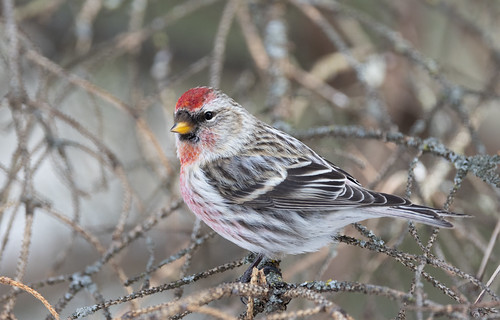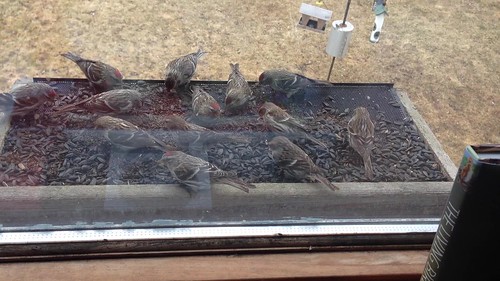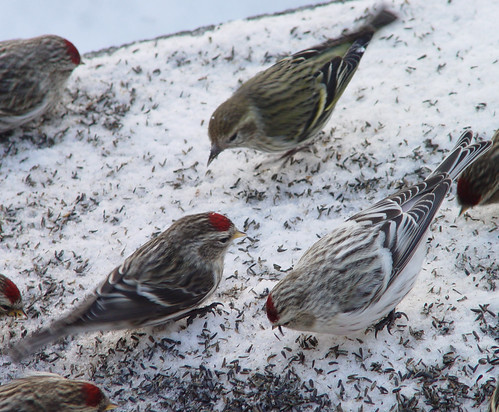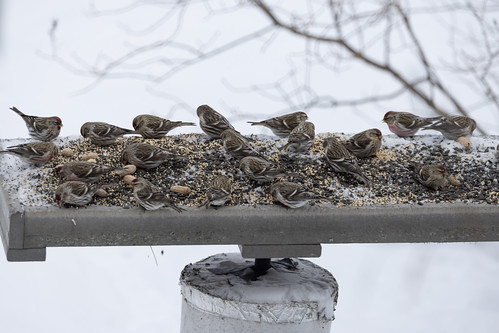This is a banner year for redpolls. People all over Minnesota and Wisconsin are posting about them on Facebook, and my email box is full of stories about these charming winter visitors. Redpolls have everything going for them as far as their popularity with people goes. They’re little, both sexes have beautiful plumage, their chattery calls are pleasant, and they seem amazingly approachable and even friendly. They get along with one another well enough that a surprising number can crowd into a single platform feeder, though if you pay attention, you can’t help but notice that some are pretty darned assertive in defending their personal space when they’d prefer not to share.
Redpolls, which are circumpolar, breed in coniferous forest and scrub of the far north, in North America through arctic Canada and most of Alaska. In Eurasia they breed from northern Scandinavia, northern Russia, and northern Siberia south to central Russia, southern Siberia, Outer Manchuria, Sakhalin and Kamchatka. For no good reason, the Lesser Redpoll of Europe also been introduced in New Zealand. On tundra and beyond the timberline, they’re found only in hollows and sheltered spots with shrubby vegetation.
Seed production in many trees varies wildly, often alternating crazily from one year to the next. In response, redpolls stay mostly in the far north when food is plentiful there, and head south in vast numbers when it isn’t. Some winters they may appear as far south as South Carolina, Alabama, and southern California, while other years they barely travel as far south as the northernmost states.
As befits a bird that can winter so very far north, redpolls are shockingly hardy. Researchers could easily look at extreme temperatures in locations where they knew redpolls were visiting feeders to establish just how hardy they are, but for some reason, some scientists thought it necessary to conduct laboratory studies in which they watched various songbirds become hypothermic and then die as the temperature in a controlled chamber was lowered degree by degree. Common Redpolls survived down to -65º F and Hoary Redpolls down to an astonishing -88º F. I don’t know if that says more about the extreme warm-bloodedness of redpolls or the extreme cold-bloodedness of some researchers.
Redpolls have many strategies to survive such extreme temperatures. Their muscle mass increases as temperatures drop below zero, enhancing their ability to shiver, which warms their core tissues. Their plumage is 31 percent heavier in November than July to increase insulation, and peripheral vasoconstriction—that is, reducing blood flow at their extremities—also thickens their insulation while concentrating the warmth in their core. The fuel that redpolls burn to warm the body in the first place is very high energy—those tiny seeds—and they can eat over a longer time in a 24-hour day than most birds because they have more rod cells in their retinas, allowing them to feed at lower light levels. And they go to sleep not only on a full stomach, but with extra food to unconsciously snack on as they sleep—their esophagus has a great many diverticula, or pouches, that they also fill as evening falls. As they sleep, after they’ve digested their stomach contents, those pouches slowly empty into the stomach, stoking their metabolic furnace through the long winter night.
Their feeding behaviors help conserve heat, too. We can’t help but notice redpolls milling about on the ground as well as in our feeders. In more natural settings, they feed on seeds clinging to trees, but don’t necessarily stay in those trees to eat. They’re much more protected from gusts of wind on the ground, allowing them to fluff their feathers to conserve their body heat. So both on their arctic breeding grounds and wherever they happen to be wintering, redpolls often shake seeds from catkins and then drop to the ground to eat them.
With such a wide arctic range, different redpoll populations show differences in bill size and plumage. Most recent ornithological research has focused on their taxonomy. Currently, scientists recognize three different species in the world, the Common and Hoary appearing in North America, and both of those along with the Lesser Redpoll appearing in the Old World. Some scientists believe there are as many as six redpoll species, but based on DNA and other data, other scientists believe all of them should be lumped into a single species. Some birders would be just as happy not having to sort through each one seeking out a Hoary, but there will be a lot of birder angst if we lose that one from our life lists.
This season, redpolls started passing through northern Minnesota in big numbers back in October. I spent a lot of time outside in November and early December watching the Rufous Hummingbird on Peabody Street and hearing redpolls, but not once did a redpoll come down to my feeders, and I only read a few accounts of them visiting other feeding stations. Why would they bother while so much natural food was available in the form of seeds still clinging to trees?
But as the season progressed and they depleted more and more of their natural food sources, they showed up at more and more feeders, in bigger and bigger numbers. Redpolls are nomadic, moving about from here to there all season, their numbers usually peaking in late March or April.
Now that they’re visiting feeders, I’m going through a lot of Nyjer seed. I put it in three small tube feeders, and pour some over the sunflower seed in the two platform feeders in my yard. My home office window feeder is the only one squirrels can get into, so I fill that one with Fiery Feast—a capsaicin-laced mixture of nuts and sunflower hearts—but with so many redpolls, I’ve also been sprinkling Nyjer seed in there. Redpolls really do concentrate on small seeds, but on Saturday I watched one pull a large peanut half from the feeder and dart into my spruce tree, where it took tiny bites as it tucked the peanut chunk into different crevices among the spruce needles. I guess I’ll have to live a lot longer than my paltry 70 years to understand even the most familiar birds.
One of my listeners, Nicole Ottjes writes:
I have lived in Duluth for 6 years in the Piedmont area, and this winter for the first time I have a huge number of redpolls every day in my yard. For the past few weeks I bet there have been 50-100 redpolls gorging on the shelled sunflower seeds in my tray feeder. To quote my neighbor, “There goes the bird food budget!” When I go out to hand-feed mealworms to my chickadees, the redpolls hang around too and land on my head and hand sometimes. They haven't eaten a mealworm from my hand yet (maybe mealworms are not in their diet?), but they are pretty intense!
Adult redpolls are primarily vegans, feasting in their natural habitat on very small seeds from birch, willow, alder, and some conifers. Their interest in insects is mostly limited to the nesting season, particularly as the best high-protein food for their growing chicks. When I mentioned that they aren’t much interested in insects in winter, Nicole quickly wrote back:
You were right - I put seeds in my hand instead of mealworms, and apparently that's all it takes. I wonder if they would have eaten from my hand if they hadn't seen the chickadees doing it already? Chickadees seem like great teachers.
Nicole sent a great video of at least a dozen redpolls flitting about and crowding into her outstretched hand.
I’ve never fed redpolls by hand, but just watching her video was thrilling. I’ve been taking lots of photos of redpolls in my feeders and trees, and this weekend made a short sound recording of their pleasant little call notes, but Nicole’s splendid video tops them all. I'm so pleased that it was her chickadees that inspired her redpolls to come to her hand.
Redpolls are thriving through all the frigid weather we’ve been having. But their habit of feeding on the ground, which works just fine year-round in their natural habitat and during the coldest period of winter in our backyard habitats, turns out to be dangerous for them when we start getting thaws as winter releases its hold. In nature, not all that many seeds collect under any single tree, but all the wasted seed and seed shells that pile up under our feeders through the winter slowly decay, fostering bacteria and mold growth. Periodic thawing hastens the process, especially as spring progresses. So those of us with bird feeders have a moral responsibility to dig out or rake out the spoiled seed whenever the weather and ground conditions allow. Composting is a perfect way to dispose of them as long as we keep the compost pile or bin screened to keep those little birds out. Like any restaurant owner, we people with bird restaurants have obligations to our diners, even if no health inspectors are checking up on us.






